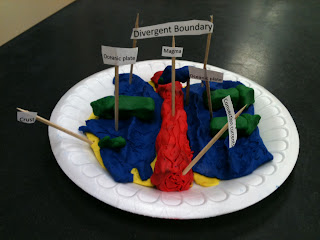For my structured inquiry, students investigated plate boundaries. Given a specific set of questions, students began by independently researching information about plate boundaries. Students recorded information in their science journals. Next, students were placed in groups. Together they shared their research and corrected misconceptions. After each group felt they had thorough and accurate data, they electronically completed and submitted a data chart. The next step of the project was to choose one boundary type and make a model of a landform that occurs at that boundary. Students completed their models in groups. Finally, each group presented a model and lead a class discussion about the landform and boundary where it occurred.
Students were very enthusiastic about this project. Students really seemed to like the idea of gathering their own information which translated into them taking control of their own learning. Students also liked the idea of being able to verify their information by working cooperatively with other students. Of course, students were very excited about making their clay models! They did such a great job. The assessments I used included an observation checklist, questioning, journals and grading rubrics. These assessments allowed me to see student learning and provide feedback. I felt student learning was evident throughout the project, especially when I listened to groups using new words they had learned from their research.
The following are examples of student work. The first sample is a completed boundary chart. This sample shows student learning as all information is provided and all directions have been followed.
The following are pictures of students' models. These models are an example of student learning because students had to create models of land forms created a specific boundary types.
Volcano formed at convergent boundary.
Sea-floor spreading at a divergent boundary.
I really like that students include convection currents in their models! They really enjoyed this part of the lesson. Overall, I am very pleased with how the lesson was carried out, and I am very proud of my students!


